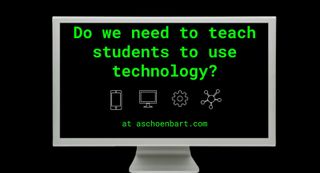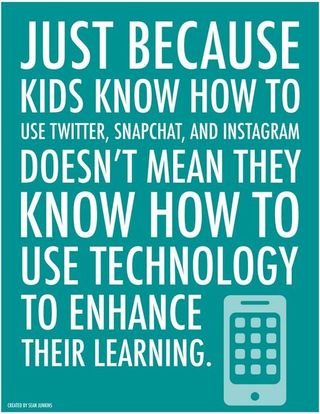Do We Need to Teach Students to Use Technology?


Four years ago, when Chromebooks were new and my students were logging on for the first time, I dedicated days of class time to exploration, practice, and play. We learned how to navigate the apps launcher, customize settings, and turn in work, developing technical skills that would later be leveraged to enhance learning. Most of it was isolated from class content, focusing instead on building comfort and relationships. And for years, that strategy worked well.
But in the last few years, I’ve reconsidered this idea, asking myself: do we still need to teach students to use technology? Back then, the question was more about whether or not we really needed technology. Now, it’s shifted to a focus on how and when to implement it meaningfully and effectively.
In my dual roles as a teacher and coach, these are questions that are asked a lot, especially at the start of the year. And this year, my approach is really changing--I will no longer directly teach technology. Instead, I want to develop meaningful applications (and review) of the tools to jump right into relationship building, inquiry, exploration, and learning. The technology should never stand on its own, but should be embedded in content and skills.
Building Capacity
As always, context matters. I know that all of last year’s eighth and ninth graders used Chromebooks and Google Classroom, so I can feel more comfortable jumping right in. Communities are new to the freshman, so I’ll spend a little more time letting them explore the platform. It’s amazing to see how we have built capacity for regular technology use for both teachers and students in the past few years. Now I know that we can use it, so it’s time to return to the questions of when, how, and why.
Developing Skills
The best teaching, in my experience, combines skills and content. We don’t study literary elements or vocabulary in isolation in my English class, but to develop deeper understandings of literature. Similarly, use of technology should help to personalize students’ learning, developing skills like citizenship, autonomy, and perseverance. These 21st century skills should be applied in every classroom and can be embedded in any content or subject area.
This graphic is from Sean Junkins on Pinterest.

Teaching for Learning
Despite not directly teaching technology skills to start the school year, it’s important to remember that just because students can use the technology doesn’t always mean that they’re ready to use it effectively in their learning. I love the quote above, which I’ve heard in many different forms, and it’s true: students will often learn to use technology on their own. But it’s our job as educators to make sure that they use it responsibly, effectively, and to enhance learning. For example, my students know how to use Twitter and Snap Chat, but when we backchannel in class or use Snap Chat for a QR code reader, students often need scaffolding, models, and instruction to make the most out of these tools.
Tech & Learning Newsletter
Tools and ideas to transform education. Sign up below.
Another great graphic courtesy of Sean Junkins on Pinterest.

In the end, as usual, it’s about knowing your students, their comfort and experiences, and your goals. Sometimes it pays to let them play and explore with technology without academic pressure---that type of play often pays off with a deeper understanding of the tools. And I hope I don’t need to teach anyone to join us on Google Classroom--they have the experience and each other. But when we need to change advanced sharing settings on Docs for the first time, I might make my technology instruction a little more explicit.
The bottom line for me--in all of my teaching this year--is to trust students to learn, iterate, adapt, and persevere. I think we will all be better off for it.
How do you incorporate technology instruction to start the school year? What technology skills or experiences are essential for your students? Share in the comments or @MrSchoenbart.
cross posted at www.aschoenbart.com
Adam Schoenbart is a high school English teacher, Google Education Trainer, and EdD candidate in Educational Leadership. He teaches grades 10-12 in a 1:1 Chromebook classroom at Ossining High School in Westchester County, NY and received the 2014 LHRIC Teacher Pioneer Award for innovative uses of technology that change teaching and learning. Read more at The SchoenBlog and connect on Twitter @MrSchoenbart.











